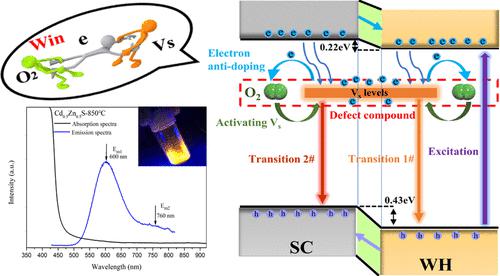当前位置:
X-MOL 学术
›
ACS Appl. Nano Mater.
›
论文详情
Our official English website, www.x-mol.net, welcomes your
feedback! (Note: you will need to create a separate account there.)
Enhanced Photoluminescence in CdxZn1–xS Solid Solution by Suppressing Non-Radiative Recombination for White Light-Emitting Diodes
ACS Applied Nano Materials ( IF 5.3 ) Pub Date : 2022-12-15 , DOI: 10.1021/acsanm.2c03632 Jiancheng Wang 1 , Beiying Zhou 2 , Jiaxin Ma 1 , Xiaobo Hu 1 , Yanqiao Xu 3 , Ping Huang 1, 4 , Erhong Song 5 , Lianjun Wang 1, 4 , Wan Jiang 2, 4
ACS Applied Nano Materials ( IF 5.3 ) Pub Date : 2022-12-15 , DOI: 10.1021/acsanm.2c03632 Jiancheng Wang 1 , Beiying Zhou 2 , Jiaxin Ma 1 , Xiaobo Hu 1 , Yanqiao Xu 3 , Ping Huang 1, 4 , Erhong Song 5 , Lianjun Wang 1, 4 , Wan Jiang 2, 4
Affiliation

|
The inevitable defects in conventional II–VI semiconductors, introducing pathways for the non-radiative recombination, substantially lower the photoluminescence (PL) quantum yield. Although considerable progress has been made toward eliminating the defect-induced PL quenching, the low stability that remained after surface passivation or only a small proportion of defects that could be modified via other strategies dramatically limits the whole PL quantum yield of solid-state luminescent materials. In this work, we propose a “defect activation” strategy to improve the luminescent performance of CdxZn1–xS solid solution. A remarkable PL enhancement is realized up to orders of magnitude compared to those of non-activated defect sites. Combining experimental investigations and density functional theory calculations, the PL enhancement mechanism clarified that the sulfur vacancies are activated by electron anti-doping from adsorbed oxygen to effectively suppress the defect-induced non-radiative recombination. The unique “defect activation” engineering will open up a perspective for the positive role of defects and inspire more explorations for achieving optimized optoelectronic materials with excellent optical characteristics and high stability for white light-emitting diodes.
中文翻译:

通过抑制白光发光二极管的非辐射复合增强 CdxZn1–xS 固溶体中的光致发光
传统 II-VI 半导体中不可避免的缺陷,引入了非辐射复合途径,大大降低了光致发光 (PL) 量子产率。尽管在消除缺陷引起的 PL 淬灭方面取得了相当大的进展,但表面钝化后仍然存在的低稳定性或只有一小部分缺陷可以通过其他策略进行修改,这极大地限制了固态发光材料的整个 PL 量子产率. 在这项工作中,我们提出了一种“缺陷激活”策略来提高 Cd x Zn 1– x的发光性能S固溶体。与未激活的缺陷位点相比,实现了高达几个数量级的显着 PL 增强。结合实验研究和密度泛函理论计算,PL增强机制阐明了硫空位被吸附氧的电子反掺杂激活,有效抑制了缺陷引起的非辐射复合。独特的“缺陷激活”工程将为缺陷的积极作用开辟新的视角,并激发更多的探索,以实现白光发光二极管具有优异光学特性和高稳定性的优化光电材料。
更新日期:2022-12-15
中文翻译:

通过抑制白光发光二极管的非辐射复合增强 CdxZn1–xS 固溶体中的光致发光
传统 II-VI 半导体中不可避免的缺陷,引入了非辐射复合途径,大大降低了光致发光 (PL) 量子产率。尽管在消除缺陷引起的 PL 淬灭方面取得了相当大的进展,但表面钝化后仍然存在的低稳定性或只有一小部分缺陷可以通过其他策略进行修改,这极大地限制了固态发光材料的整个 PL 量子产率. 在这项工作中,我们提出了一种“缺陷激活”策略来提高 Cd x Zn 1– x的发光性能S固溶体。与未激活的缺陷位点相比,实现了高达几个数量级的显着 PL 增强。结合实验研究和密度泛函理论计算,PL增强机制阐明了硫空位被吸附氧的电子反掺杂激活,有效抑制了缺陷引起的非辐射复合。独特的“缺陷激活”工程将为缺陷的积极作用开辟新的视角,并激发更多的探索,以实现白光发光二极管具有优异光学特性和高稳定性的优化光电材料。

































 京公网安备 11010802027423号
京公网安备 11010802027423号